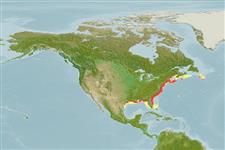>
Eupercaria/misc (Various families in series Eupercaria) >
Sparidae (Porgies)
Etymology: Stenotomus: Greek, stenos = narrow + Greek, stoma = mouth (Ref. 45335).
More on author: Linnaeus.
Environment: milieu / climate zone / depth range / distribution range
Écologie
marin démersal; océanodrome (Ref. 51243); profondeur 15 - ? m (Ref. 4926). Subtropical; 46°N - 25°N
Western Atlantic: Nova Scotia in Canada to Florida in USA; rare south of North Carolina, USA.
Length at first maturity / Taille / Poids / Âge
Maturity: Lm 15.5 range ? - ? cm
Max length : 46.0 cm TL mâle / non sexé; (Ref. 7251); common length : 25.0 cm TL mâle / non sexé; (Ref. 9988); poids max. publié: 2.1 kg (Ref. 40637)
Occurs usually in schools inshore in summer and offshore in winter. Feeds on amphipods, worms, sand dollars and young squid (Ref. 4926). Utilized fresh, smoked and frozen; eaten pan-fried, broiled and baked (Ref. 9988). Exported to Japan (Ref. 9988)
Robins, C.R. and G.C. Ray, 1986. A field guide to Atlantic coast fishes of North America. Houghton Mifflin Company, Boston, U.S.A. 354 p. (Ref. 7251)
Statut dans la liste rouge de l'IUCN (Ref. 130435)
Menace pour l'homme
Reports of ciguatera poisoning (Ref. 30911)
Utilisations par l'homme
Pêcheries: commercial; pêche sportive: oui; Aquarium: Aquariums publics
Outils
Articles particuliers
Télécharger en XML
Sources Internet
Estimates based on models
Preferred temperature (Ref.
123201): 9.4 - 24.6, mean 23.5 °C (based on 106 cells).
Phylogenetic diversity index (Ref.
82804): PD
50 = 0.7500 [Uniqueness, from 0.5 = low to 2.0 = high].
Bayesian length-weight: a=0.01738 (0.01048 - 0.02881), b=3.01 (2.87 - 3.15), in cm total length, based on LWR estimates for this species & (Sub)family-body (Ref.
93245).
Niveau trophique (Ref.
69278): 3.8 ±0.1 se; based on diet studies.
Résilience (Ref.
120179): Milieu, temps minimum de doublement de population : 1,4 à 4,4 années (K=0.17-0.23; tmax=19).
Fishing Vulnerability (Ref.
59153): Moderate to high vulnerability (51 of 100).
Climate Vulnerability (Ref.
125649): Moderate vulnerability (40 of 100).
Nutrients (Ref.
124155): Calcium = 78.5 [35.6, 139.6] mg/100g; Iron = 1.03 [0.55, 2.10] mg/100g; Protein = 19.3 [18.2, 20.5] %; Omega3 = 0.332 [0.195, 0.556] g/100g; Selenium = 30.7 [14.6, 62.3] μg/100g; VitaminA = 7.68 [2.00, 29.30] μg/100g; Zinc = 0.578 [0.379, 0.855] mg/100g (wet weight);
